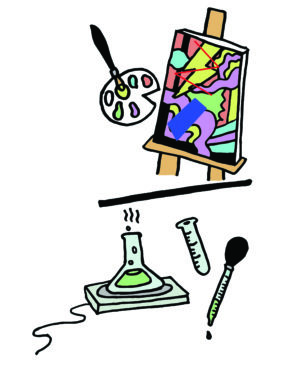From the perspective of a scientist

At university, students are squeezed into categories on a daily basis. The classes we take begin to define and channel our thinking. We become either a scientist or an artist — not both. But if you are defined as a scientist, should that mean that you can only communicate with fellow scientists? Both scientists and artists have a lot to say, but they are only conversing with themselves. This is partly a result of scientists presenting their ideas in long, highly complex papers that are inaccessible to a large majority of the population.
In a recent article, ScienceMag suggested that artists should embrace technology (the output of science) whilst scientists should engage in the artistic process. But that implies that each needs to become more like the other, and everybody should be both. What if scientists were simply able to fully appreciate art while artists engaged in scientific discussion? What if artists and scientists formed a mutualistic symbiotic relationship? A close, long-term relationship between two living entities, where both parties benefit.
Scientists pride themselves in being finders of truth. But artists do the same. While scientists explore, in depth, the mechanisms that allow life to proceed (backed by mathematical and statistical proof), artists explore the truths of what it means to exist in space and time. Each is just as meaningful and important as the other.
Now imagine a world where scientific findings were accessible enough to be understood by all, so that creative minds could use the knowledge to actually move society forward.
Climate change is a brilliant example. The concept is so misunderstood that politicians can get away with saying things like “It’s freezing and snowing in New York — we need global warming!” In order for the biggest environmental problems of our time to be solved, everyone must first have a strong foundational knowledge of the problem. It is from that place that we can move forward with thoughtful and innovative solutions.
So whose job is it to make scientific knowledge accessible to all? Is it scientists themselves? Should artists be responsible for their own understanding of science? Whatever the solution is, it starts with education.
Until UVic offers more interdisciplinary courses that simultaneously exercise both the right and left hemispheres of our brains, I challenge you to seek out the opinions of others.
Here at UVic, science students are required to take science courses and science electives to train our brains to think solely in scientific terminology and mathematical proofs. Uvic’s Science Web Page states, “As a science student at UVic, you won’t just memorize facts. You’ll see how the concepts you’re learning can be applied to problems like diseases and climate change.” And although some classes do provide knowledge on these problems, science education needs to be taken a step further. We need to be given tools to be able to pass on this information and take steps toward solving the problems we learn about. There is no requirement to take a scientific communications course, in fact, such a course doesn’t even exist at UVic.
Maybe this high degree of specialization in education isn’t so bad. After all, the society that we’ve constructed demands the production of highly specialized individuals to function.
So, then, the solution to this divide is a third party. One that is educated in both art and science, one that can see how the two aren’t so different after all.
There is a space that exists where art and science overlap, just like a venn diagram. A space where scientific principles can be applied to human systems, where the chemical reaction in a glass beaker is a beautiful metaphor for our everyday interactions.
Humans are divided and isolated in so many ways. Our education should unite us rather than perpetuate further divides. At the end of the day, it is a marriage of both scientific and artistic thinking that is needed to solve the interdisciplinary problems facing humanity. However we go about bringing the two together, whether it be through educating scientists in the arts and vice-versa, or having a middle man between the two, humans must first accept and respect other ways of knowing.
Until UVic offers more interdisciplinary courses that simultaneously exercise both the right and left hemispheres of our brains, I challenge you to seek out the opinions of others, talk to someone outside of your degree and ask them for their take on one of the many complex problems of our modern society.








